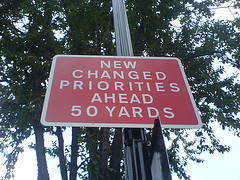
How To Prioritize Your Task List
Mondays are productivity days at SimpleProductivity blog.
There are a lot of theories and methods out there for determining what task to do next. Some say do it by where you are (context). Some say to do things by putting them in four quadrants. And Mark Forster says to do it by lead time.
Context Can Be Important
Yes, I believe context should play into things, because obviously you can’t read a book if you don’t have a book to read. You can’t make phone calls if you don’t have access to a working phone. That is just common sense.
However, what happens when you have everything you need right at hand to accomplish any of your tasks? Suddenly context doesn’t become such a reliable method.
Everything On The List Is Important
My main problem with the quadrant system is that two of the quadrants have a label of unimportant.
My question is, if the task is unimportant, why are you even bothering to put it on the list at all? Why waste time doing unimportant things when there are important things to be done?
So I believe that everything on your task list should be important. If it isn’t important, it shouldn’t even be on your task list.
If Everything Is Important, How Do You Choose?
Now we are back to the problem of having multiple contexts available. What do you choose what to do when you have no limits?
You need to choose the work based on date.
But not due date. Rather, how long it will take you, or the lead time needed.
Lead Time Example
Let’s take the following projects: you have to plan your daughter’s birthday party; you have to plan the Girl Scout carnival; you have to get the gutters on the house cleaned; and you have to buy a new television antenna by the time your mother arrives for her visit (because she cannot live without television). The carnival has several sub-tasks, including securing the space, buying prizes and notifying the troops.
Here are the dates:
- Birthday party: September 13
- Girl Scout carnival: September 26
- Gutters: September 15
- Antenna: September 1
Looking at due dates alone, you would pick the antenna, because it is the first to be due. However, it will only take three days for the antenna to arrive from Amazon, once you have purchased it. That is the lead time. Here are the lead times with the events:
- Birthday party: three weeks in order to purchase the Minecraft party favors
- Girl Scout carnival: six weeks in order to secure the location and insurance; four weeks to receive prizes; five weeks to notify the troops
- Gutters: two weeks because that is how far Mr. Jim’s Gutter Cleaning is backlogged
- Antenna: three days to deliver from Amazon.
This puts the dates the projects need to be started as follows:
- Birthday party: August 23
- Girl Scout carnival: August 15 (location/insurance); August 22 (notify troops); August 29 (buy prizes)
- Gutters: September 1
- Antenna: August 28
So by using the lead time rule, the next thing you should do is secure the space and insurance for the carnival, then notify the troops, then purchase the Minecraft favors, then purchase the antenna, then buy the prizes for the carnival, then schedule the gutter cleaning.
Conclusion
By using lead time to determine when things need to be done, you keep yourself on schedule and have a great way to get through the task list.
What do you think? Do you take lead time into account? Do you think unimportant tasks have a place on the task list? Share below.
Photo by Banalities. Licensed under Creative Commons.




